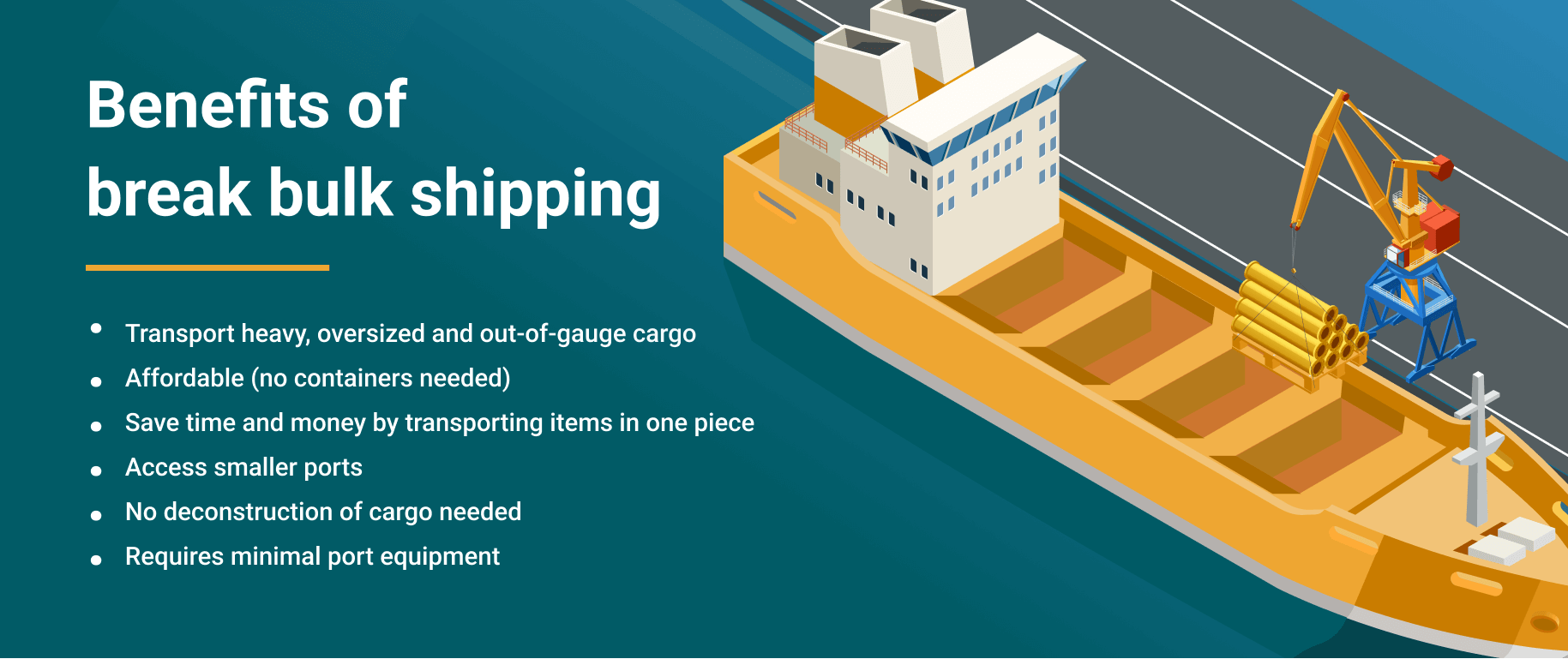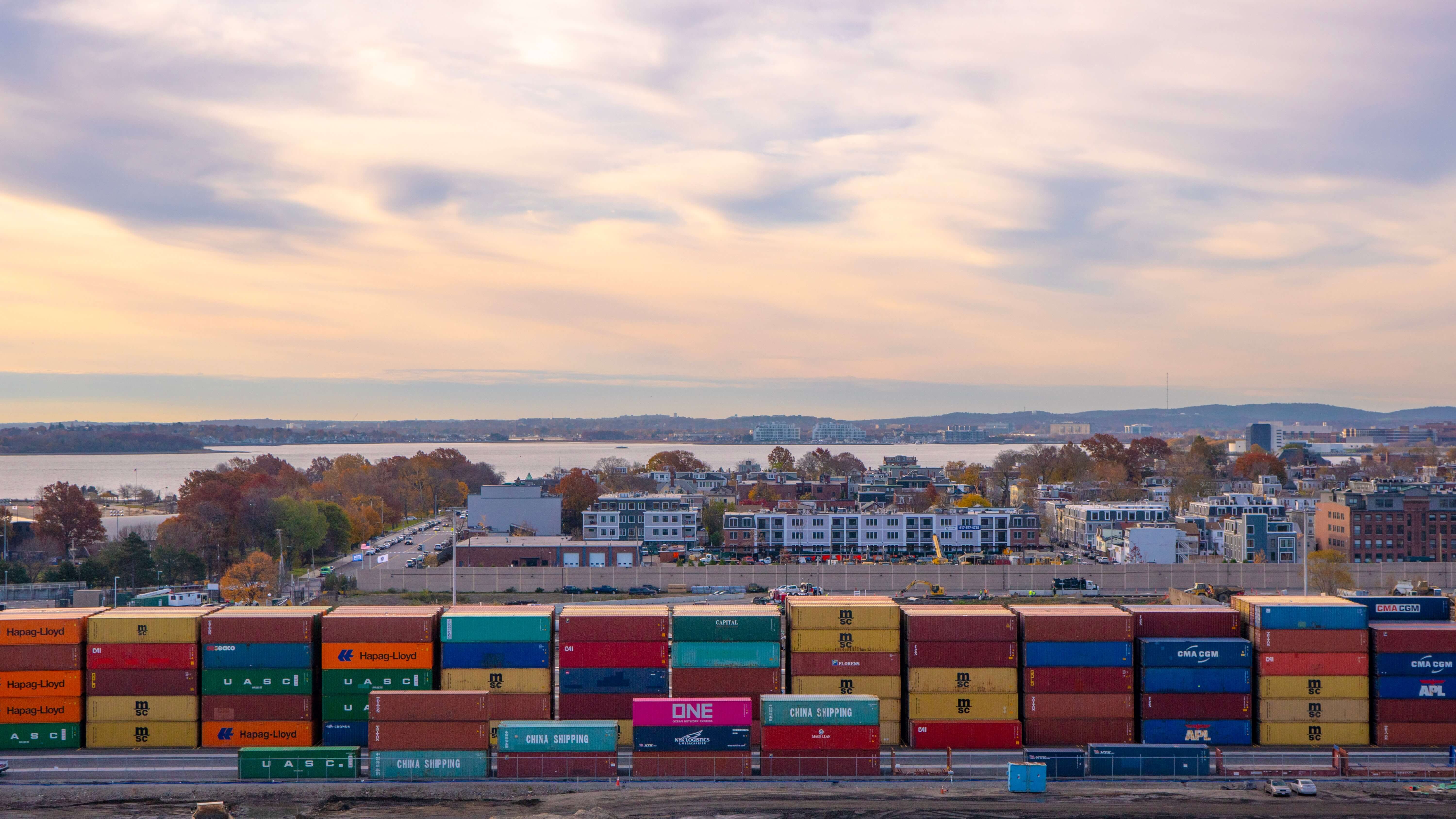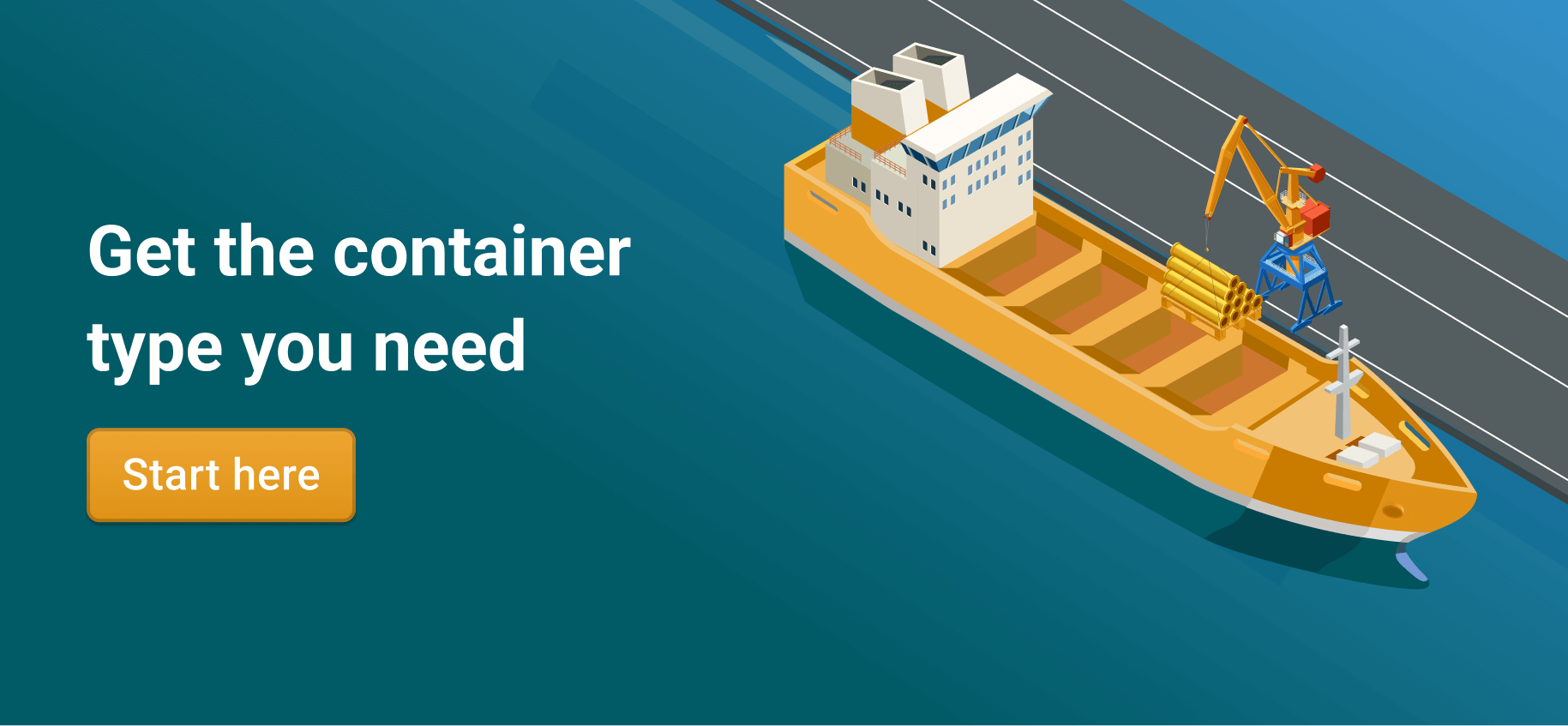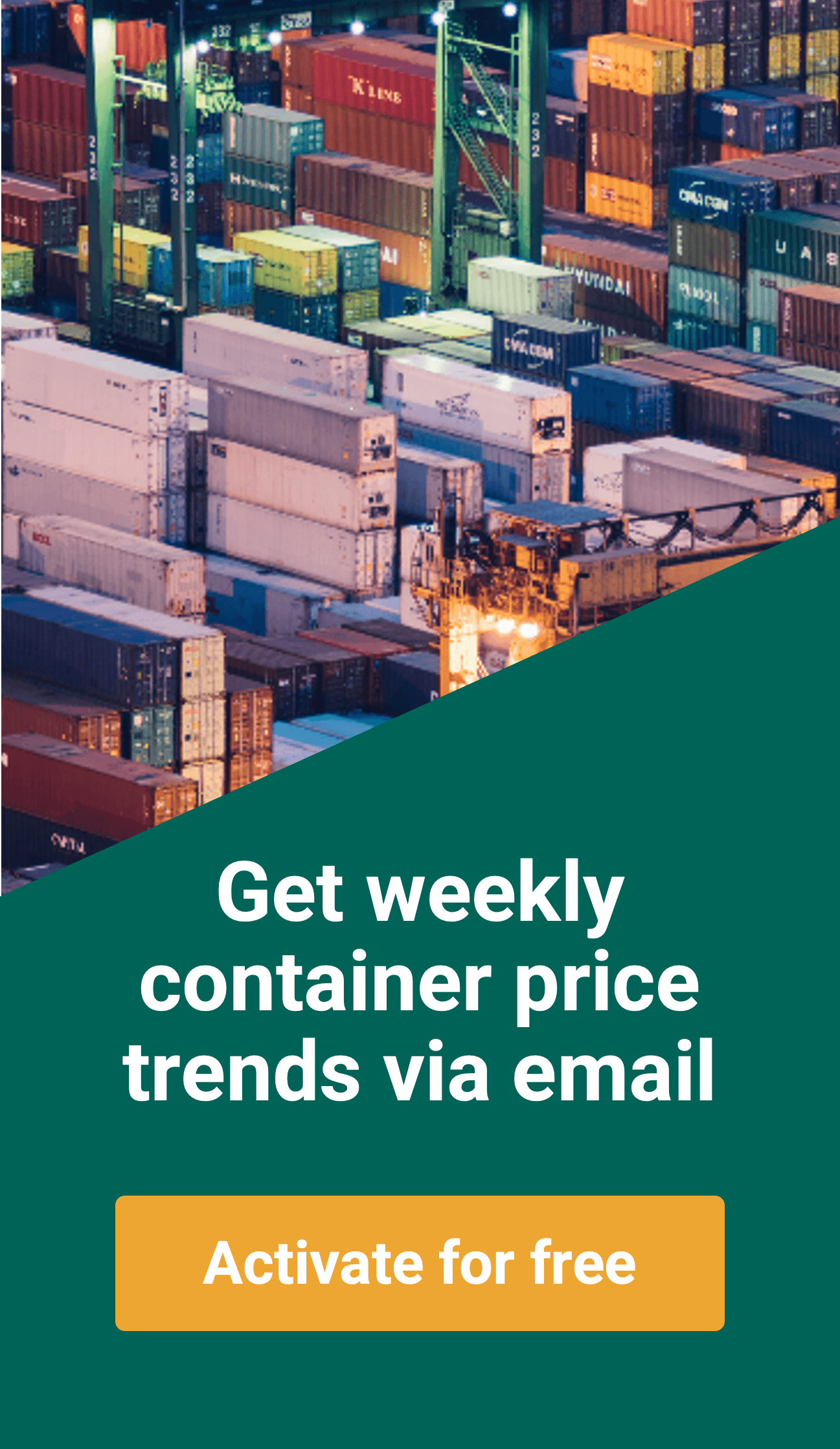Does the term break bulk shipping leave you scratching your head? In this blog, we’ll cover the benefits and challenges of break bulk, as well as how to find boxes of all kinds on Container xChange. Want boxes right away? Click here to talk to an expert today.
Need to transport construction equipment or large machinery? It goes without saying you’re not going to squeeze these items into a shipping container, even if it’s a 45ft high cube! You’ll need to opt for break bulk shipping. But don’t worry, we’ll explain the ins and outs of this shipping method below, so you can feel completely prepared and in-the-know.
Shipping smaller cargo and need a specific container type, such as a standard box, a reefer or a flat rack? On our transparent and neutral leasing platform, we’ve got containers of all types and sizes available.
Want to check out just how easy it is to find the boxes you need on Container xChange? Simply choose ‘I want to use containers’ below, type in your pick and up drop off location, and get searching right away!
What is break bulk shipping?
Break bulk shipping is the transportation of cargo that doesn’t fit into standard or special shipping containers. Items are packed into bags, pallets, drums, or boxes, or loaded as is onto the vessel.
Break bulk cargo is loaded using cranes, rolled, or wheeled onboard. To be considered break bulk, items must be loaded individually, and not in a shipping container of any kind.
The term ‘breaking bulk’ means to unload a portion of a ship’s bulk, or to start the unloading process. This harks back to the good old days of shipping when all cargo was transported in individual units, and manually loaded and unloaded by dock workers. Today, break bulk shipping is still crucial in the shipping industry.
Items usually shipped break bulk include: minerals, grains, ores, oils and gasses. The bill of lading reflects the total volume or weight of the shipment, not that of the individual units. Break bulk also includes large machinery, building materials and construction vehicles.
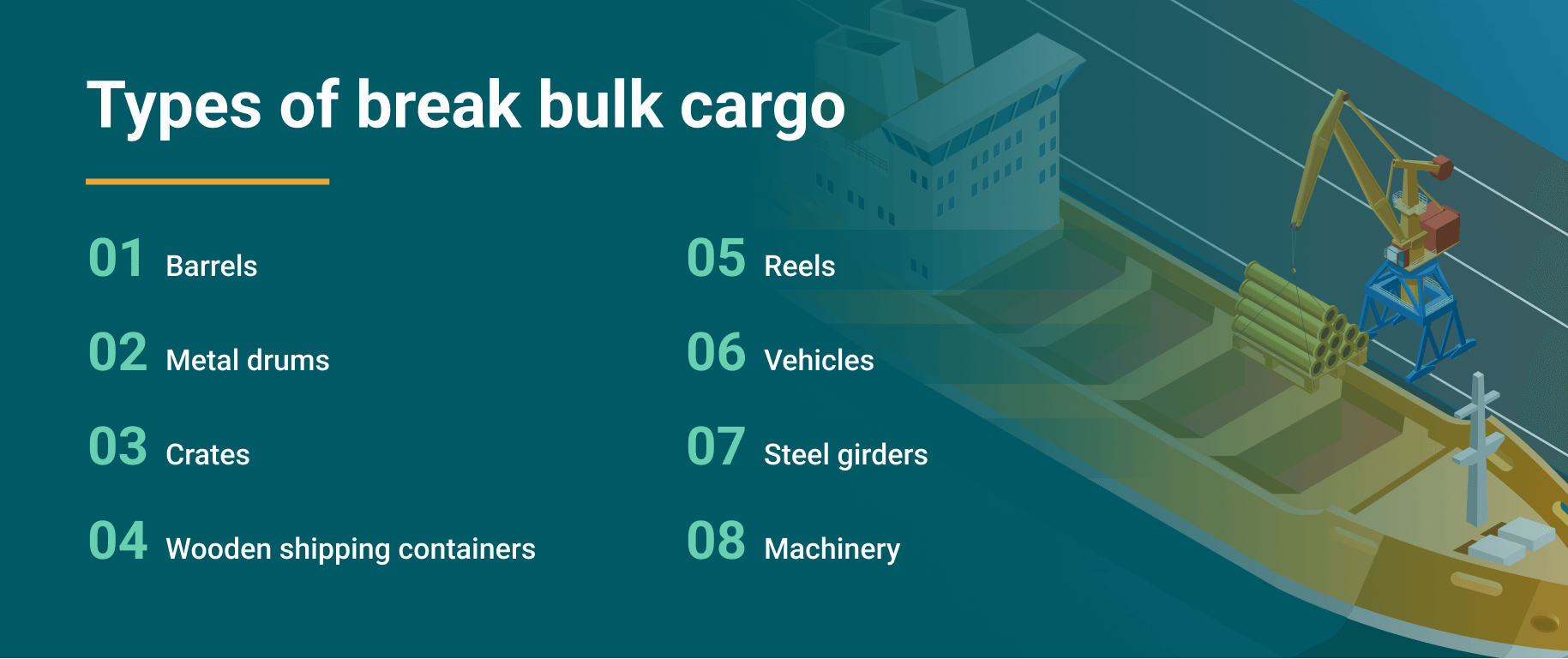
We will get into more detail on the different categories of break bulk cargo in the next section.
Types & examples of break bulk cargo
For large, oversized and heavy cargo, we can separate items into one of three categories.
Project cargo
Project cargo includes extra large, heavy-duty, high-value, and complex items. This cargo type is usually deconstructed before loading. Project cargo demands special care and attention and usually needs to be delivered within certain timelines and budgets.
Think about it like this. An airplane is being built, but the wing parts need to be shipped from another country. The longer those parts take to arrive, the longer it takes for the airplane to be finished and put to use. Time is money, so project cargo is usually time-sensitive.
Project cargo is also seen as the most challenging cargo type to ship. It requires very detailed shipment plans, and can be very costly if anything goes wrong.
Project cargo is shipped by these industries:
- Mining
- Construction
- Power plants
- Renewable energy
- Aerospace
- Military and defense
- Engineering
- Oil and gas
Heavy lift cargo
As the name suggests, heavy lift cargo is extremely heavy to transport and load. It’s often impractical to deconstruct this kind of cargo before loading, so it must be loaded in one piece. Heavy lift cargo tends to weigh over 100 tons/90718,5kgs and measure over 100 meters in height/width.
Usually, heavy lift items are not of standard sizes or shapes, and require special planning before transporting and loading.
Heavy lift cargo includes:
- Generators
- Turbines
- Reactors
- Boilers
- Satellites
- Towers
Out-of-gauge cargo
Out-of-gauge cargo is any cargo that doesn’t fit into a standard six-sided container, such as a 40ft shipping container. This includes all items with a length over 12.05 meters, a width over 2.33 meters, or a height over 2.59 meters. Again, shipping this kind of cargo requires careful planning and communication.
Out of gauge cargo includes:
- Machinery
- Vehicles
- Specialized artworks
- Mining equipment
- Aircraft parts
So what is general or standard cargo? This is any cargo that can fit into a standard or special shipping container, including grains, paper, clothing, electronics, food items, liquids/gasses and vehicles. Want to learn more about the different kinds of shipping containers out there? Check out this informative blog post on container types.
How does break bulk shipping work?
Break bulk cargo is transported to the port via trucks or trains, and loaded directly onto the vessel. Sometimes, it arrives early and is stored in a port warehouse until the ship arrives.
Once the ship arrives, break bulk items are brought to the ship. This is usually done when a large amount of break bulk cargo is ready for loading, and is transported in several batches.
Before break bulk is loaded onto a ship, the ship’s hold must be washed and dried thoroughly, to make sure it’s clean and sterile.
Once the vessel arrives at the port, it is unloaded directly onto trucks and train wagons, and transported to its final destination. Sometimes break bulk cargo has to be stored in port warehouses and collected by the consigneeWhat is a consignee? When transporting freight (by ocean, air, or land), there are two parties involved — one who is shipping and the other who is receiving the freight. The recipient of the goods b... More at a later stage.
Types of break bulk ships
There are two main types of break bulk vessels: Roll on/Roll off (RoRo) and Lift on/Lift off (LoLo). These terms stand for both a vessel type and a loading method.
RoRo vessels: These vessels have decks so that goods are rolled on and off the ship. This type of vessel is perfect for wheeled machinery, vehicles and boats.
LoLo vessels: These vessels have on-deck cranes for loading and unloading cargo. These cranes are able to lift extremely heavy loads.
How is break bulk cargo loaded and unloaded?
Let’s take a look at how different kinds of break bulk cargo is loaded and unloaded:
| Break bulk category | Loading and unloading method |
| General break bulk cargo | Bundled in unit loads and hoisted using nets, slings and crates, or stacked on trays, pallets or skids. |
| Heavy lift break bulk cargo | Transported on a heavy-lift vessel. Loaded using cranes, ramps, submersion technology, and/or tug boats. |
| Project cargo | Loaded in pieces (disassembled) using cranes, or rolled using ramps (if parts have wheels). |
| Out-of-gauge cargo | Loaded using cranes or rolled using ramps (especially for vehicles or wheeled machinery). |
Got cargo that doesn’t fit into the break bulk category? Perhaps you need a standard or special container for your shipment. Good news! You can get containers of all kinds and sizes on our neutral online marketplace.
Click below to set up a demo with one of our friendly experts today. Learn how you can become a member on xChange, and start leasing and trading containers in no time at all.
Overview of the break bulk industry
Today, container ships transport over 90% of non-bulk cargo around the world. Containerization, which came about in the 1960s, has drastically improved the efficiency of the shipping industry by saving time and reducing costs. However, break bulk shipping, the original method of transporting cargo, still has an important place in the industry.
In 2020, Global Security projected that bulk and break bulk shipping took up about half of all cargo (by volume) entering the USA, making up a large portion of the shipping market overall.
That being said, this industry is not without its obstacles. One such challenge facing the break bulk industry is the need to move towards more sustainable shipping methods, including producing ‘green’ materials and switching to more sustainable fuels. This is both costly and time-consuming. If the industry doesn’t get on board quickly enough, it could start to fall behind.
Another challenge is the increasing scale of break bulk cargo such as wind technology, which demands bigger vessels, cranes, decks and infrastructure to handle these larger items. This has a major impact on port infrastructure, as well as break bulk vessel design.
Then, of course, there is digitization, which is being rapidly adopted in ports around the world. In order for the break bulk industry to keep up with an ever-evolving shipping world, digital technology needs to replace legacy systems. This again is time-consuming and requires large amounts of investment capital.
However, break bulk doesn’t seem to be going anywhere. As industries like the renewable energy sector and aerospace engineering continue to ramp up production, larger and larger cargo will need to be transported around the world to meet the growing demand.
Benefits of break bulk shipping
With container shipping the preferred method of shipping, you might be wondering why some shippers still use the break bulk method? Here are some of the advantages:
Affordable
If you’ve got large machinery, taking it apart to fit it into containers can be expensive. And then, it’s got to be reassembled again later on. Plus, you have the cost of leasing or buying the containers. For this reason, break bulk shipping can be an affordable alternative for shipping oversized cargo.
Perfect for oversized, heavy, and out-of-gauge cargo
Break bulk is the perfect solution for oversized, heavy, and out-of-gauge cargo that can’t fit into any kind of standard or special shipping container.
Saves time
If your goods don’t need dismantling, you can save a lot of valuable time. You simply roll or lift your cargo onto the ship as is, and secure it safely. You’ll also only need one bill of lading number because the item is in one piece.
Can make use of smaller ports
You can ship break bulk cargo to most ports around the world. This is because it requires little to no deconstruction and reconstruction. And loading and unloading cranes are readily available on break bulk ships. So, this leaves cargo independent of port equipment.
Disadvantages of breakbulk shipment
Although break bulk has many benefits, there are some challenges and disadvantages to this shipping method as well.
High risk
Project cargo is often extremely valuable and therefore, risky to transport. If this type of cargo is breaks, it’s very expensive to fix or replace. You can bet that insurance for shipping project cargo is pricey too. Luckily, now days, there are ways to completely enclose larger items, keeping them safe from damage during shipping.
Higher cost per unit
Whilst you save on container fees with break bulk cargo, larger items take up a lot of space on a vessel and can be pricey to transport. Break bulk is priced per metric ton or cubic meter. So for very large items, you could be looking at steep totals. Luckily, this is often offset with savings in other areas.
Lack of break bulk vessel availability
Unlike standard shipping vessels, break bulk and multi-purpose vessels don’t always work to specific schedules. This can make finding the right carrier at the right time in the right place tricky.
Break bulk shipping vs bulk shipping
Perhaps your mind is racing and you’re thinking: but what about the difference between break bulk shipping and bulk shipping? We’ve got the answers you need, so keep reading.
As you know by now, break bulk shipping involves the transport of cargo in bags, boxes, crates and pallets, or on its own. These cargo items are not transported in shipping containers.
Bulk cargo is also shipped without containers. The major difference? It’s placed loose in the ship, rather than inside boxes, barrels or drums before being loaded. Bulk cargo includes items like grains, cereals, coal, iron ore and rock.
Want to learn more about the differences between break bulk and bulk shipping? Hop over to this informative blog article to keep reading about this topic.
Difference between break bulk vs container shipping
Now let’s have a closer look at the differences between break bulk shipping and container shipping.
| Break bulk shipping | Container shipping |
| Items that can’t be packed into a shipping container | Cargo that can be packed into a standard or special shipping container |
| Loaded using vessel lifting equipment or rolled on board | Loaded using cranes |
| Cargo is placed directly on board and unloaded directly at the port | Cargo needs to be loaded and unloaded from shipping containers |
| Not suitable for transporting food or temperature sensitive items | Used to transport food and temperature sensitive goods |
Find the ideal container for your cargo on Container xChange
So your cargo doesn’t fit into the break bulk category, and you need a shipping container. Container xChange is your one-stop container solution!
Container xChange is a neutral and transparent marketplace for leasing, buying and selling shipping containers in over 2,500 locations around the world. What’s more? We’ve got over 10,000 quality containers just waiting for you to lease or buy!
Sick of unreliable partners? On xChange, we vet and pre-approve every member. You heard right. All of our partners are reliable and professional, so you can finally source containers from trusted suppliers.
Curious about our prices? Hop onto this blog to learn all about the competitive container prices on our platform. Speaking of prices, when it comes to payments, we guarantee you 100% payment security with the xChange wallet. Keep track of all of your payments in one place, and receive just one monthly invoice. At last, the simplicity you’ve been craving.
On xChange, you can do it all on one streamlined platform; from searching for boxes and negotiating deals, to invoicing and container tracking. No more switching accounts and trying to remember countless login details. It’s so simple.
Want to become a member of Container xChange, and start finding quality boxes from trusted sources? Click below to get a free demo today.
What is break bulk shipping?
Break bulk shipping is non-containerized shipping. It is used to transport oversized cargo such as machinery, building materials and vehicles, as well as cargo transported in bags, barrels, wooden boxes, pallets and metal drums.
Is break bulk cheaper than using shipping containers?
When break bulk shipping is used to transport large and oversized items, it can help with cost savings. This is because with break bulk shipping, large items are loaded directly onto the vessel, and don’t need to be dismantled - which can be expensive and time-consuming.
What is the difference between LoLo and RoRo?
LoLo (Lift on/Lift off) and RoRo (Roll on/Roll off) are types of shipping vessels, designed to load items in different ways. LoLo ships allow for cranes and lifting equipment, whilst RoRo cargo must be rolled on and off the ship.
What is the break bulk process?
General break bulk cargo is shipped in barrels, drums, pallets or wooden boxes. Large machinery and vehicles are lifted or rolled onto the vessel in one piece, and are secured onboard using lashing rings made of strong and durable materials.
![Want to know about break bulk shipping? [+ benefits 2022]](png/benefits-of-break-bulk-shipping.png)



